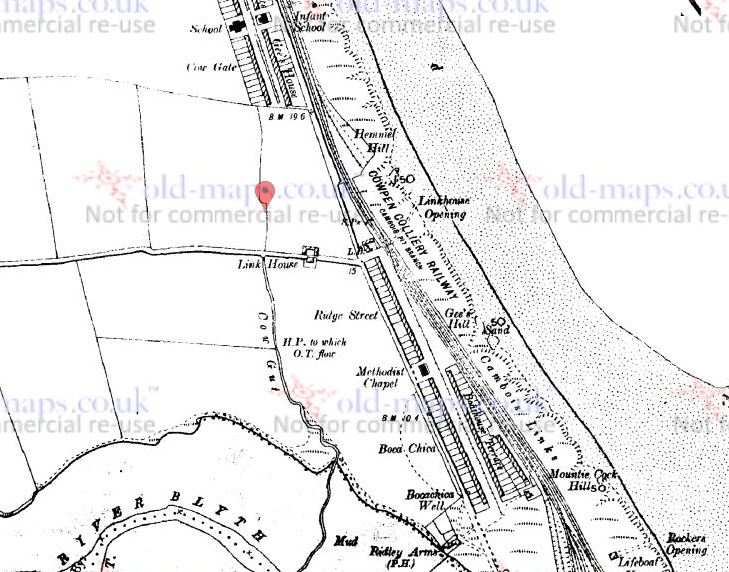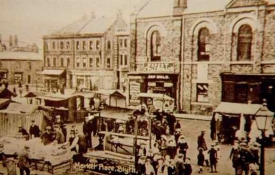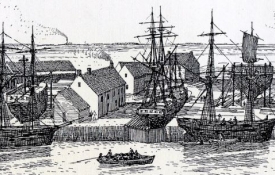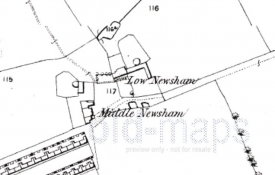Welcome to the Community View section of the website. This area is dedicated to articles of interest, community information and local topics that are submitted by members of the public or guest writers. It is also the main section dedicated to the Youth Media Group Project.

In 1872 a reporter from the Newcastle Chronicle toured the colliery villages of the North East. His observations were published in a series of articles called "Our Colliery Villages". This is what was written about the new colliery village of Cambois:
"The situation of Cambois is a very peculiar one, and the island, as it is often called, is somewhat difficult of access. Upon the north Cambois is bounded by the Wansbeck; on the south by the Blyth, the distance between the two mouths of the two rivers being about two miles. On the west the place is almost intersected by some of the tributaries of the Blyth and Wansbeck; and it is almost impossible to go from Cambois to any of the places near without using a bridge or boat. On the east Cambois is bounded by the North Sea, for most of the colliery houses are built on the links - indeed, the most westerly of the rows is not more than three or four hundred yards away from high-water mark on the sands. Some of the rows are close to the shore - so close, in fact, that the inhabitants may at night be lulled to sleep by the peaceful murmur of a tranquil sea, or roused from slumber by the thunder of the angry surge, to gaze on dismal scenes of storm and shipwreck.
Had Cambois been easier of access than it is, it would in all probability ere now have been the site of a large fishing village, or, perhaps, a fashionable watering place, for it has good sands and stands in a nice bay. We might even predict that it may some same day or other become a watering place, for has it not already its row of houses fronting the sea, and bearing the stylish title of Sea View, so strongly suggestive of Scarbro’ that I involuntarily looked in the windows for the wintry sign, “Lodgings to let?”
By way of a joke, I might further predict that the days are to come, when Lord Macaulay’s New Zealander comes down to this part of the country to make his wondering and reflective survey, he may amuse himself by sitting on the top of the old worked-out pit-heap, and gazing down upon the ruins of model bathing machines, of model sea-side lodging houses, which were once the abode of pitmen, or may watch with pitying eye, but inward satisfaction, the last of the famous breed of lodging-house cats, wearing out its ninth life in the vain endeavour to find another morsel of lodging-house food among the ruins of “Boca Chica.”
I might, if I choose, register this valuable idea about making Cambois a watering-place; but I rather fancy that it would be somewhat difficult, in the absence of a bridge across the Blyth, to get lodgers to come; and I suppose the idea of a bridge across that river is almost as daringly speculative as the vision of the illustrious New Zealander.
Cambois is quite a new colliery, and it is a little more than five years since the first shipment of Cambois coal was made. On such a large scale, however, have mining operations been conducted that, at the present time, there are few if any collieries in the North of England which return such a large annual output. The total output of the last year was 325,207 tons, but the largest output ever reached in any one day by the pit has been 1,793 tons. The natural deduction from figures like these is, that to hew and get to bank such an immense quantity of coal, a large number of men and a powerful and complete system of machinery are necessary.
At the present time, the pit employs something like 850 men and boys and the winding and pumping-engines are magnificent specimens of engineering skill. The Pumping-engine which was built by Hawthorn, of Newcastle, is quite a change upon the old system of pumping out water by means of an engine on the bank, for it is built upon quite a different principle to the old beam-engines which are in use at most places. This engine is simply a horizontal-engine of great power placed at the bottom of the mine itself, where it quietly proceeds with its gigantic work of lifting to the surface about 500 or 600 gallons of water per minute. This engine and its four boilers stand in large and lofty chambers cut for them in the solid rock, and to all appearance they are just like the engine-rooms of some our large factories.
The winding-engine is also a fine piece of work, and its power and efficiency are vouched for when we remember that it must have been hauled to bank in one day the great weight of 1,793 tons of coal, to say nothing of taking the hands up and down.
With a colliery working under such scientific management, one ought naturally to expect to find the comfort of the men employed well looked after, and houses built for them worthy the name of human habitations. Nor is this expectation disappointed, for the houses built in Cambois are of a very superior order indeed. To begin with the houses of the officials (which stand in what is known as Quality Row), they are compact, lofty houses, with four rooms each in them, rooms which in size are about 17 or 18 feet square, with a commodious pantry behind, and further back still, at a distance of 20 or 30 yards, you have privies and ashpits. At the front of these houses, and, indeed, in front of all the houses in the place, you have a vegetable garden, which is fully the width of the house and nearly thirty yards in length. Most of the kitchen floors are cement, the floors of the earliest erected ones being of large flat bricks and others of wood.
The houses of the officials are, of course the best in the place and without gardens, would let in Newcastle for £14 or £16 a year. There are altogether twelve rows of houses in the place, the most northerly and the most southerly being about one mile and a half apart, so that they cannot be said to be crowded. One or two of the oldest rows are built of stone, but they, in common with all the others, are roofed with slate and are large and nicely fitted up. The prevailing type, however, is of brick, all the bricks having been made upon the colliery, the description of one of these rows will serve for all, as there is little difference in them.
The most southerly row is what is known as Boca Chica, and it contains 46 houses out of the grand total of about 350, which go to make up the colony, with a view, I suppose, of giving the rows a somewhat spicy appearance the house at each end stands a few feet further out than the others, and presents, towards the road, a somewhat dandified, not to say rakish, looking gable-end surmounted by a “star-pointing pyramid” of stone. Boca Chica derives its peculiar name from its nearness to some houses on the banks of Blyth, which, for the last hundred years or more, have gone by that name.
This name the place obtained from its being the residence of two old tars who had served under Admiral Vernon at the siege of Carthagena. One of the outposts of the place was called Boca Chica, and the frequent recurrence of this queer name in the fine spun yarns of the old salts caused someone to give the place of their residence the name Boca Chica, and Boca Chica it has remained unto this day.
The houses in this row have a good-sized garden in front, but, as might be expected from their near proximity to the sea, the soil is very light and sandy, and will take years of careful cultivation before it can be expected to become very fertile. After passing through the garden, the kitchen entered by an approach of two or three steps, and is a fair sized room, with nice fireplace, oven, and pot. Behind the kitchen a wash-house is formed and out of the wash-house a staircase with hand-rail leads to the upper storey, which contains two decent sized bedrooms, to say nothing of a sort of lumber room outside the bedroom doors and immediately under the slates.
These bedrooms are vastly different places from the garrets of Seghill and Killingworth, and much better than even the new houses in the course of erection at Burradon, indeed, the lumber rooms of Boca Chica would make far snugger bedrooms than any of the garrets of Seghill. Outside, and at a good distance from the back doors, is the privy for each house, with its accompanying ash-pit, behind which runs a waggon-way for the conveyance of coals to each house.
Each house has its own sink at the back door, and all drainage is carried off either into the river or into the sea. Everyone seems perfectly satisfied with the houses they live in, reserving always, of course, the English privilege of grumbling a little. The water supply is furnished by several wells from which water has to be carried, and this water carrying is one of the things of which the good wives of Cambois complain, as does the schoolmaster, whose pupils are kept at home to act as drawers of water.
The water of Boca Chica well is noted for its excellence and a man with a horse and barrel drives a flourishing trade at the high end of the village by selling it at a low price of one halfpenny per pailful. This can scarcely be wondered at in a place like Cambois, which is only in its infancy, when we consider that the flourishing township of Cowpen, with its Local Board and more double the population of Cambois, is in a far worse position as to water supply, and is under the necessity of receiving the good offices of its itinerant water-cart.
As I said last week, a good supply of water might easily be laid on to every house in our large collieries, and at none of them could it be more easily done than at Cambois. It is an improvement much needed, and need cost the owners nothing, for I am perfectly sure that their men would be quite willing to pay a water rate if water pipes were laid into the houses. Some of the houses are at least a quarter of a mile away from the nearest well, and the labour of washing day must be almost doubled by the hard work of water carrying.
At present there is only one school at Cambois, and it is rather crowded with its average daily attendance of 200 scholars, male and female; but another and larger school is in the course of erection, and will soon be ready. The schools are built by the owners; but there is no compulsory rate, and only those pitmen who send their children to them are charged anything in the shape of school fees. The only chapel in the place is in the hands of the Primitives, who are generally well represented in our pit villages. During the present year, a Mechanics’ Institute has been built by the owners, and although not yet finished, the number of members on the books is 140. The subscription is only sixpence a month, and the number of members ought to be treble the present figure. Down stairs is a large room which will hold three or four hundred people, and is very suitable for lectures or public meetings. The reading room and library occupy the upper storey.
Co-operation thrives well in Cambois. For the society numbers no less than 300 members, and turns over nearly 250 per week. Last quarter but one the dividend paid was 3s. 3d. in the pound, though the September dividend was only 2s. 10d., a much higher figure than is reached by the large majority of similar societies.
From its isolated position, Cambois is a very quiet place, and there is less crime committed there than in most pit villages with anything like so large a population. There are only two public houses in the place or near the place, and they are so far apart that, while one stands close to the banks of the Wansbeck, the other has its doorstep laved by the high tides of Blyth.
The greatest drawback, however, to the comfort of Cambois is the great difficulty and inconvenience experienced from the want of means of communication with other places. Blyth is the nearest town of any importance to Cambois, for it is not more than a mile away; but to get to Blyth you must cross the river in a boat, and if the tide is low you have to wade through the mud and slush for a distance of fifty yards at each side of the river. For years now, a bridge has been talked of by the Blyth and Cowpen people, but in all probability the matter will end in talk, and vested interests will still be allowed to obstruct the execution of a work of great public utility and necessity.
For carts, carriages, and horses, the only means of crossing from the Cowpen side to Cambois is by the large ferry-boat; but if the weather be stormy, all such vehicles must go round by Bedlington, a course by which the straight line of one mile between the places is multiplied into a circuit of eight times that length.
I think the Blyth and Tyne Railway Company made a great mistake in not taking their Newbiggin branch through by Blyth and Cambois, for by so doing they would not only have greatly increased the number of passengers from Blyth to Newbiggin, but they would have been the gainers of all the traffic from Cambois to Blyth, a traffic which is every year increasing, and thus, while benefiting themselves, have conferred a great boon upon the people of Cambois."



